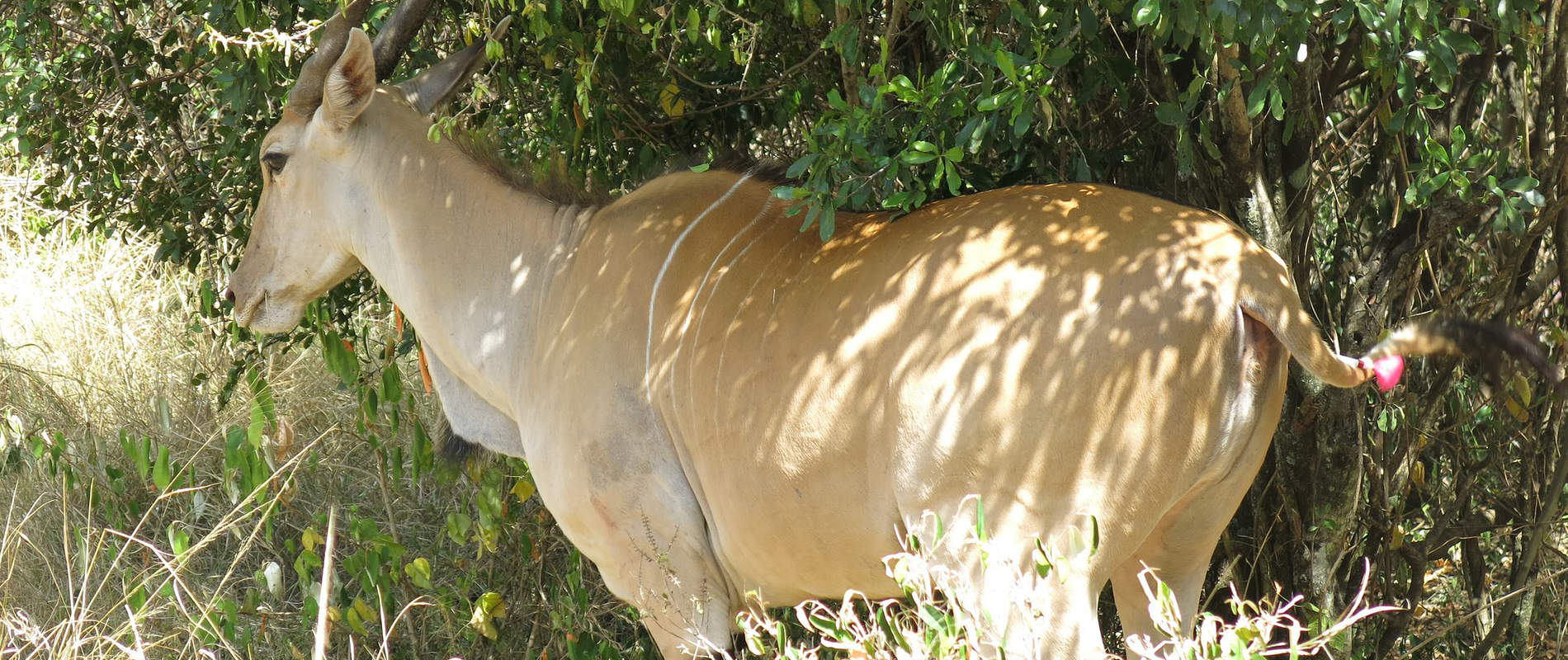FIELD VETERINARY REPORT FOR MASAI MARA-AUGUST 2016 By Dr
FIELD VETERINARY REPORT FOR MASAI MARA-AUGUST 2016
By Dr. Campaign K Limo
Introduction
The period under review was characterised by drop in precipitation with more dry and windy days. Most of the grass has been utilized by the migratory wildebeests currently occupying much of the Masai Mara Ecosystem. Most of the elephants have moved out of the reserve to surrounding conservancies and community areas. Water for animals is still available throughout the ecosystem.
The following were cases handled during the month;
CASE#1 RE-TREATMENT OF AN ARROWED ELEPHANT
Date: 12th August 2016
Species: African elephant
Sex: Female
Age: Adult
Location: Mara Bush Tops Conservancy.
History
This elephant had been treated the previous month for an injury to the inner side of her right front limb. At the time, she was in a thick bush and darted on foot but could not move much and fell on her left side within the thicket. Access to the wound at that time was limited as she lay on the wrong side and on a terrain which the vehicle could not access for flipping her over. With limited options the wound was cleaned, probed as much as possible and no foreign body found. After giving her antibiotics and anti-inflammatories, she was revived to avoid compromising her life. A repeat immobilization and further examination treatment was scheduled to be carried out after two to three weeks. Rangers were tasked to monitor her until the second treatment.
On the morning of the 12th August, the BushTops Rangers called the Unit having seen her with a number of other elephants.
She had improved tremendously but there was need for further examination and treatment. She was in an open plain presenting the best opportunity for immobilization and better examination.
Immobilization, examination and treatment
She was chemically restrained by use of 15mgs Etorphine hydrochloride delivered in a 3ml dan-inject dart from a vehicle. She was prevented from accessing the nearby thicket before giving in to anaesthetics after eight minutes. This time she assumed right lateral recumbency presenting us with the perfect position for examination.
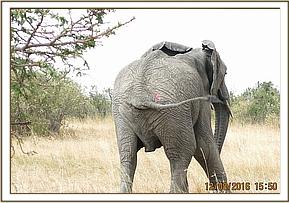

Thorough examination of the wound was carried out which involved extending the wound opening and dissecting deeper into the tissues. An arrow head was found firmly embedded deep in the tissues beyond sight and easy reach. The arrow head was removed and the wound debrided with Hydrogen Peroxide, lavaged with copious amount of water and disinfected with tincture of iodine. Green clay was finally packed into the wound. In addition this elephant received intramuscular injection of 30000mgs amoxicillin antibiotic and 5000mgs flunixin meglumine anti-inflammatory.


Reversal
Reversal of the anaesthetic was achieved by administration of 36mgs Diprenorphine hydrochloride through a prominent ear vein. She was helped to her feet with the use of ropes and she stood up and moved away strongly.
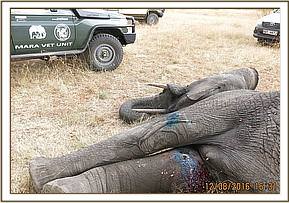

Prognosis
This elephant cow is expected to make full recovery.
CASE#2 TREATMENT OF AN ARROWED GIRAFFE
Date: 16th August 2016
Species: Masai Giraffe
Age: Adult
Sex: Female
Location: Lemek Conservancy
History
This giraffe had been spotted with an arrow sticking from her neck by KWS rangers on patrol two days prior to her intervention. However she disappeared as soon as the veterinary team headed for assistance. She re-appeared two days later and was successfully treated.
Immobilization, examination and treatment
She was found in an open field with a herd of about twenty giraffes with an arrow sticking out on her left side of the neck. She was still in good body condition. She was chemically restrained by use of combination of 12mgs Etorphine hydrochloride and 50mgs Azaperone delivered in a 3ml dan-inject dart. The drugs took effect after eight minutes and she was effectively restrained by roping her down.


The barbed arrow was gently pulled out and the resultant wound debrided with Hydrogen peroxide, before tincture of Iodine and Oxytetracycline wound spray were applied.
Additional treatment included parenteral administration of 10000mgs Oxytetracycline anti-biotic and 1500mgs Flunixin meglumine anti-inflammatory.
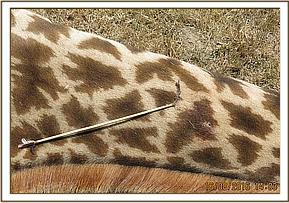
Reversal
Reversal of the anaesthetic was achieved by administration of 24mgs Diprenorphine hydrochloride intravenously through the jugular vein. She rose up immediately to join the rest of the herd.
Prognosis
Good. The arrow was not poisoned.
CASE#3 TREATMENT OF AN INJURED LION
Date: 16th August 2016
Species: African lion
Age: Adult
Sex: Male
Location: Mara North Conservancy (Near Duma Camp)
History
This lion was seen limping by the Duma Camp management and called us for assessment and possible treatment. This lion was found lying at the edge of a small shrub with his brother some distance away. He seemed relaxed and had recently fed.
When agitated to move, he did so with slight limp on his right front limb. No visible wound could be seen but he seemed to have sprained his carpal joint during a hunt.
Treatment
The team felt he did not need to be immobilized but anti-inflammatory drugs were delivered remotely using 3mls dan-inject dartS from a vehicle. A total of 12mgs of Dexamethasone sodium anti-inflammatory drug was successfully delivered remotely with the dart falling out as soon as drugs were delivered.
Prognosis
Good.
CASE#4 RE-LOCATION OF AN ELAND
Date: 17th August 2016
Species: Eland
Age: Adult
Sex: Female
Location: Fig Tree camp
History
This eland, possibly orphaned a long time ago, had become semi-habituated around Fig Tree Camp within Masai Mara National Reserve.
Of late she had stationed herself within the camp with increased aggressiveness towards people. There was need to move her back into the reserve to join other eland herds.
Capture and relocation
She was restrained chemically by use of combination of 8mgs Etorphine hydrochloride and 50mgs Azaperone delivered in a 1.5ml daninject dart from foot.
The drugs took full effect within eight minutes with the eland assuming sternal recumbency. She was loaded onto a truck on sternal recumbency and released thirty kilometres into the park away from human habitation to join a herd of other elands close by.


It is hoped she will live with the newly found herd.
CASE#5 DE-SNARING OF A ZEBRA
Date: 20th August 2016
Species: Common zebra
Age: Adult
Sex: Female
Location: Naboisho conservancy
History
This zebra thought to be part of the migratory group was seen by Naboisho Conservancy Rangers with a loose plain wire snare round her neck. She was still in good health and grazing with a group of other zebras. They informed their management who in turn called the veterinary unit for help.
She was found grazing with other zebras and wildebeests in good condition. The wire round her neck was visible though not tight to strangulate her.
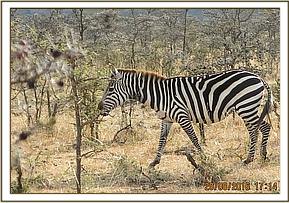

Immobilization and snare removal
She was chemically immobilized by use of a combination of 5mgs Etorphine hydrochloride and 50mgs Azaperone delivered in a 1.5ml dan-inject dart from a vehicle. It took seven minutes for the drugs to take full effect with the zebra assuming left lateral recumbency. The snare was then removed and as it was loose there was no resulting wound so the zebra was revived immediately.
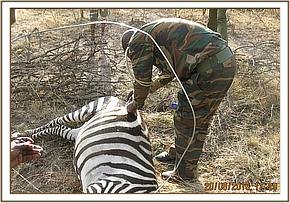

Reversal
Reversal of the anaesthetic was achieved by administration of 12mgs Diprenorphine hydrochloride intravenously through the jugular vein. She rose up in two minutes to join other zebras.
Prognosis
Good.
CASE#6 TREATMENT OF AN ARROWED ELEPHANT
Date: 21st August 2016
Species: African elephant
Sex: male
Age: Adult
Location: Olarro Conservancy
History
Olarro Conservancy rangers saw this elephant with an arrow sticking out of his right abdomen and informed their management who requested Veterinary Assistance.
This elephant was seen in company of about thirty elephants browsing by the edge of a thicket. An arrow head could be seen in the right side of his abdomen with some clear discharge.
Immobilization, examination and treatment
Immobilization was achieved by use of 15mgs Etorphine hydrochloride delivered through a 3ml dan-inject dart from a vehicle. Upon darting, the other members of the herd got agitated and moved away. He followed them into the thicket along a Lugga and the drugs finally took effect after seven minutes and he assumed right lateral recumbency. He had to be flipped using ropes and a vehicle in order to access the injury.
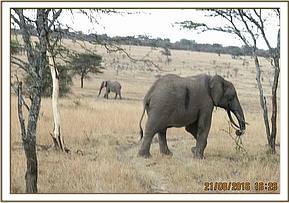

The Arrow head that had been in place for approximately one day was retrieved. It was a barbed arrow but luckily it was not poisoned. The resultant wound was debrided with Hydrogen peroxide, rinsed with clean water and tincture of iodine applied. Cloxacillin ointment and green clay was then infused into the wound.
Additional treatments included parenteral administration of 15000mgs Amoxicillin antibiotic and 4000mgs flunixin meglumine anti-inflammatory.


Reversal.
Achieved by administration of 36mgs diprenorphine hydrochloride through a prominent ear vein. He woke up in three minutes to join the herd.
Prognosis.
Good.
CASE#7) POST MORTEM OF A BLACK RHINO
Date: 21st August 2016
Age: Adult
Sex: Male
Location: Masai Mara National Reserve
History
This male black rhino christened Parkire had been treated previously on two occasions for a deep penetrating wound to his left hind leg suspected to have been a gunshot wound. The first intervention was carried out on June, 17th 2016 within Masai Mara National Reserve close to border with Tanzania.
At that time, the wound was suspected to have been three days old with fresh bleeding. Palpation revealed a small crack to the proximal portion of tibiofibular bone. After the first treatment there was tremendous improvement with this rhino relocating deep into the reserve; a distance of more than eight kilometres, browsing normally with occasional use of the affected limb.
He later on disappeared for a week but was finally spotted by the rhino patrol team having suddenly deteriorated in condition.
A second treatment was advised and subsequently done on 1st August 2016 with little improvement. His body condition had deteriorated sharply and he succumbed on the morning of 21stAugust 2016.
A Prompt post mortem was then carried out with the following revelations;
General observation;
- This rhino had fallen into a Lugga with a small stream upon death
- He was found on right lateral recumbency
- There was no evidence of struggle before death at this location as this rhino appeared to have rolled into the Lugga as he was dying. The head of this rhino was partially submerged in the flowing water but there was no evidence of aspiration
- His body condition was poor with bony prominences discernible. He had a body score of 2 in a scale of 1-5 with 1 poor and 5 good
- Both horns were intact and had been fitted with transmitter and transponders
- Apart from the wound to the left hind leg and a healed abrasion on his left flank, no other injury could be seen on the carcass
- The injured limb was severely atrophied due to underuse
On opening the carcass, the following observations were made;
- There were indications of severe anaemia. There was little volume of blood recoverable.
- There was evidence of gelatinous fatty degeneration. This is a sign of prolonged debility.
- Assessment of the injured limb showed a penetrating wound on the proximal inner side of the tibiofibular bone with a ventro -dorsal course caused by a high velocity projectile. This caused a crack on the tibio-fibular bone with further damage to the knee joint. There was partial rupture of the joint capsule with escape of the joint (synovial) fluid. Tracing the loci of this projectile revealed it was deflected ventrally upon hitting the bony part of this joint and finally lodging itself in the muscular tissues of this leg close to the ankle joint where it was recovered.
- There was massive damage to the soft tissues of this leg in addition to damage to the knee joint and surrounding osseous tissue. There was also evidence of osteomyelitis development
Conclusion
This rhino died of complications that arose after sustaining a gunshot wound which included severe loss of blood, osteomyelitis and generalised sepsis, immunosuppression from stress and pain among other challenges.
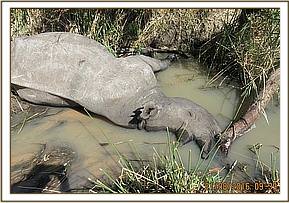

Both horns were recovered and handed over to county security team for accounting and custody. The recovered projectile was handed over to KWS investigation team for further analysis and follow-up.
CASE#8 TREATMENT OF AN ARROWED ELEPHANT
Date: 26th August 2016
Species: African elephant
Sex: Male
Age: Adult
Location: Musiara (Masai Mara National Reserve)
History
This massive bull was seen by the Masai Mara Reserve rangers with an arrow sticking from his right flank in a swamp in Musiara area within the reserve. He was in company of a herd of about thirty elephants. They called the veterinary unit for assistance. Access to the marsh with vehicles was impossible and this bull with the rest of the herd appeared to be in no hurry to leave.
Immobilization, examination and treatment
After several attempts to push this bull out of the marsh failing the team decided to seek the services of a helicopter to try push him out. He was eventually pushed out and darted from a helicopter using 16mgs Etorphine hydrochloride delivered in a 3ml dan-inject dart. It took ten minutes for the drugs to take full effect with this elephant assuming left lateral recumbency.


Examination revealed an arrowhead lodged in his right flank, the shaft having fallen soon after the elephant was darted and pushed out of the swamp. The arrow head was gently pulled out and the resultant wound thoroughly cleaned with Hydrogen peroxide and copious amount of water. The arrow appeared to have been in place for one day. Ticture of iodine disinfectant and cloxacillin ointment antibiotic were also applied.


Additional treatments included parenteral administration of 15000mgs amoxicillin antibiotic and 4000mgs flunixin meglumine anti-inflammatory.
Reversal
Reversal of the anaesthetic was achieved by intravenous administration of 42mgs Diprenorphine hydrochloride through a prominent ear vein. He woke up after three minutes and moved away.
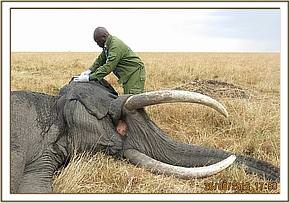

Prognosis
Good. The arrow was not poisoned.
CASE#9 TREATMENT OF A LION WITH FIGHT INJURIES
Date: 28th August 2016
Species: African lion
Sex: Male
Age: Adult
Location: Talek area (Masai Mara National Reserve)
History
This lion was seen with serious fight injuries by a tour guide on the morning of 26th August 2016. He reported this to the veterinary unit. Immediate search in conjunction with the county rangers was fruitless as this lion had moved away into hiding. The search continued for the next two days and he was finally located some kilometres away from the initial spot.
He was found lying in a small bush near a lugga with two females nearby. A carcass belonging to a topi was seen nearby and assumed to have been killed by the females. This injured male looked well fed and it was thought he had a share of the topi meal. He had injuries to his back, left front and left hind limb all suspected to have been caused by fight with other lions.
Immobilization, examination and treatment
Restraint was achieved chemically by use of a combination of 4.8mgs Medetomidine and 250mgs Ketamine delivered through a 3ml dan-inject dart from a vehicle. This male was completely anaesthetized after ten minutes.
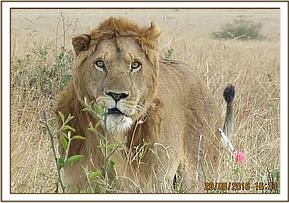

After making sure he was stable, examination was conducted which revealed deep bite wounds to his back, left hind and forelimbs. The wounds were thought to have been caused by fights with other males over territories and were relatively fresh. All the wounds were debrided with Hydrogen peroxide, rinsed with clean water and wiped dry with sterile gauze swab. Tincture of Iodine disinfectant and Cloxacillin antibiotic were then applied. In addition this lion received 3000mgs Amoxicillin antibiotics and 16mgs Dexamethasone sodium anti-inflammatory, all given intramuscularly.
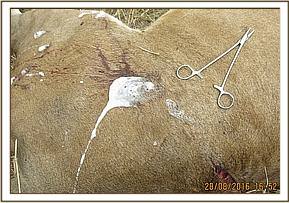

Reversal
Reversal was achieved by intramuscular administration of 15mgs Atepamezole hydrochloride one hour after immobilization. He woke up ten minutes after reversal and moved towards the females.
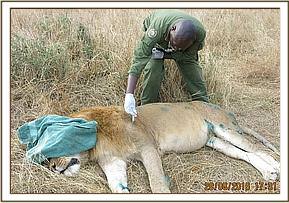

Prognosis
Good.
Conclusion
The Mara Mobile Veterinary Unit is grateful to everyone who contributed in one way or another to saving the wild life that required veterinary intervention during the period.
Thanks to Minara Foundation through The DSWT for their continuous facilitation to the unit. Thanks to KWS management for their technical support and advice to the unit. All your contributions are acknowledged and appreciated by the unit.
